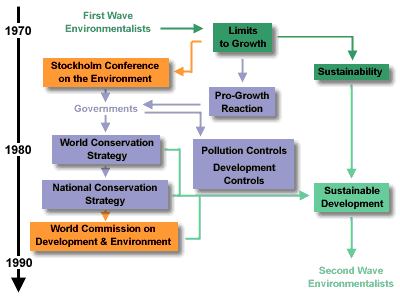|
|
|
| Back to Main Menu.. |
| Shift to ESD | ||||
|
Although many governments did not recognise the importance of global environmental problems, they were forced by community pressure to respond to local pollution problems. During the 1970s many countries introduced new environmental legislation to cope with the gross sources of pollution. Australian state governments, following the international trend, introduced clean air acts, clean water acts, and legislation establishing regulatory agencies to control pollution and manage waste disposal. The decade that followed saw a backlash against the early environmentalists. Various writers argued that global catastrophe was the fantasy of doomsday forecasters and that scientific discoveries and technological innovations would easily cope with any problems that might arise. Government departments and agencies found it extremely difficult, in this new climate of opinion, to administer properly the legislation that had been put in place at the height of the first wave of environmentalism and businesses did their best to ignore the laws or get around them. The renewed interest in sustainability in the 1980s moved away from the original conception that economic growth cannot be sustainable to a new formulation which seeks to find ways of making it so. The limits-to-growth model has been replaced with the sustainable development model, and the ‘gloom and doom’ scenario has been replaced with one of hope. Earlier environmentalists had used the term sustainability to refer to systems in equilibrium: they argued that exponential growth was not sustainable, in the sense that it could not be continued forever. In contrast, sustainable development seeks ways to make economic growth sustainable, mainly through technological change. In 1982, the British Government began using the term 'sustainability' to refer to sustainable economic expansion rather than the sustainable use of resources. This new formulation recognises that economic growth can harm the environment but argues that it does not need to. Many of the ideas associated with sustainable development had been previously articulated in the 1980 World Conservation Strategy produced by the International Union for Conservation of Nature and Natural Resources (IUCN) in collaboration with the UN Environment Programme (UNEP) and the World Wildlife Fund (WWF, now the World Wide Fund for Nature). This document, which was circulated to all governments, defined conservation as: the management of human use of the biosphere [the thin covering of the planet that sustains life] so that it may yield the greatest sustainable benefit to present generations while maintaining its potential to meet the needs and aspirations of future generations. The World Conservation Strategy argued that while development aimed to achieve human goals through the use of the biosphere, conservation aimed to achieve those same goals by ensuring that use of the biosphere could continue indefinitely. National conservation strategies based on this World Conservation Strategy were adopted in fifty countries including Australia, which adopted a national conservation strategy in 1984 following two conferences and 550 submissions. The Australian national conservation strategy, like the World Conservation Strategy, argued that development and conservation were different expressions of the one process and that economic growth could be achieved through a more appropriate use of resources. It called for sustainable modes of development, a new international economic order, a new environmental ethic and population stabilisation. The World Conservation Strategy and the Australian equivalent have had little impact and few people have even heard of them. However in the mid-1980s the World Commission on Environment and Development rejuvenated the concept in its report Our Common Future, (also referred to as the Brundtland Report, named after the commission’s chair, Gro Harlem Brundtland, who was prime minister of Norway at the time). In October 1987, the goal of sustainable development was largely accepted by the governments of one hundred nations and approved in the UN General Assembly. The commission defined sustainable development as: development that meets the needs of the present without compromising the ability of future generations to meet their own needs.
Source: Sharon Beder, The Nature of Sustainable Development, 2nd ed. Scribe, Newham, Vic, 1996. |
||||
© 2001 Sharon Beder

